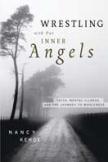The Psychology of Belief
I began this book with the hope of helping to change the face of mental illness,” states Nancy Kehoe, a member of the Religious of the Sacred Heart and a clinical instructor in psychology at Harvard Medical School. Wrestling With Our Inner Angels is an important book. Kehoe’s thesis is clear: dealing with the religious and spiritual dimension of mental patients is often the key to understanding and treating their illnesses. She insists that mental health professionals must go beyond guidelines advising that the religious and spiritual dimension be avoided on the assumption that this dimension is often a contributing factor to mental illness.
In the early 1980s Kehoe challenged this assumption and began inviting mental health day-treatment patients to participate in spiritual beliefs and values groups. The book relates her experiences with these outpatient groups—3,224 sessions over 27 years. Kehoe selects some dozen individuals for consideration, presenting in vivid narratives both their family backgrounds and their history of institutionalization in mental health facilities. The individuals chosen have a religious and spiritual dimension that becomes central to an adequate understanding and treatment of their condition—a dimension, Kehoe points out, hitherto systematically ignored in their treatment.
But Kehoe has another criterion for selecting her subjects: each contributed significantly to her own wholeness: “For a long time I had a ‘we-they’ mentality. As one of the ‘healthy’ staff, I, the professional, was helping the ‘unhealthy.’ Looking back, I can see the change in me, though I can’t name the time or the place when the tide shifted. But I know I have become, in the words of one of my patients, ‘an honorary mental patient.’” Each narrative includes a personal reflection on what Kehoe in dialogue with her clients has realized about her own “journey to wholeness.” Indicating surprise at an insight emerging from a client, she recalls the client’s admonishing her, “We may be crazy but we’re not stupid.”
Chapter Six, “The Dilemma of Voices,” is particularly interesting. Kehoe confesses a lifelong tension between her vocation to the convent and her desire for marriage and a family. She explains that her entry into the convent was precipitated by a clearly perceived inner voice calling her to enter the convent of the Religious of the Sacred Heart: “I want you to go to Kenwood.” This tension remained beyond her early religious formation, through her various teaching assignments, through doctoral studies and even through her initial practice as a mental health therapist.
Kehoe candidly admits that she had never been fully comfortable acknowledging this voice as the voice of God until she began working with her clients. By working with clients who hear similar voices, she finally came to acknowledge that her original call to the convent was truly the voice of God. She began realizing further that despite continual interior strife, her moments of deepest wholeness and peace accompanied her in living out her vocation. This experience, she notes, was not unlike those of her clients, who despite persistent inner conflict recognize an inner voice at the core of who they are and find wholeness responding to that voice, whether or not they name it God.
Kehoe notes that since most therapists take a stance of disbelief toward their clients’ inner voices, clients become hesitant to reveal them. She advises such skeptical and unbelieving therapists to consider the possibility that these individuals do have internal life-giving voices even in the midst of chaotic, hallucinatory experiences. Therapists should help their clients explore these voices, enabling them to distinguish between constructive and destructive dimensions.
All concerned with faith, mental health and the journey to wholeness—whether from a spiritual-religious or a psychological perspective—will not only enjoy reading this book but be encouraged to reflect more deeply on the author’s thesis. Kehoe’s purposefulness should energize mental health professionals to join her in asserting the centrality of the religious-spiritual dimension of care. Can there be any human wholeness without the integration of the Transcendent?
This article also appeared in print, under the headline “The Psychology of Belief,” in the October 26, 2009, issue.








